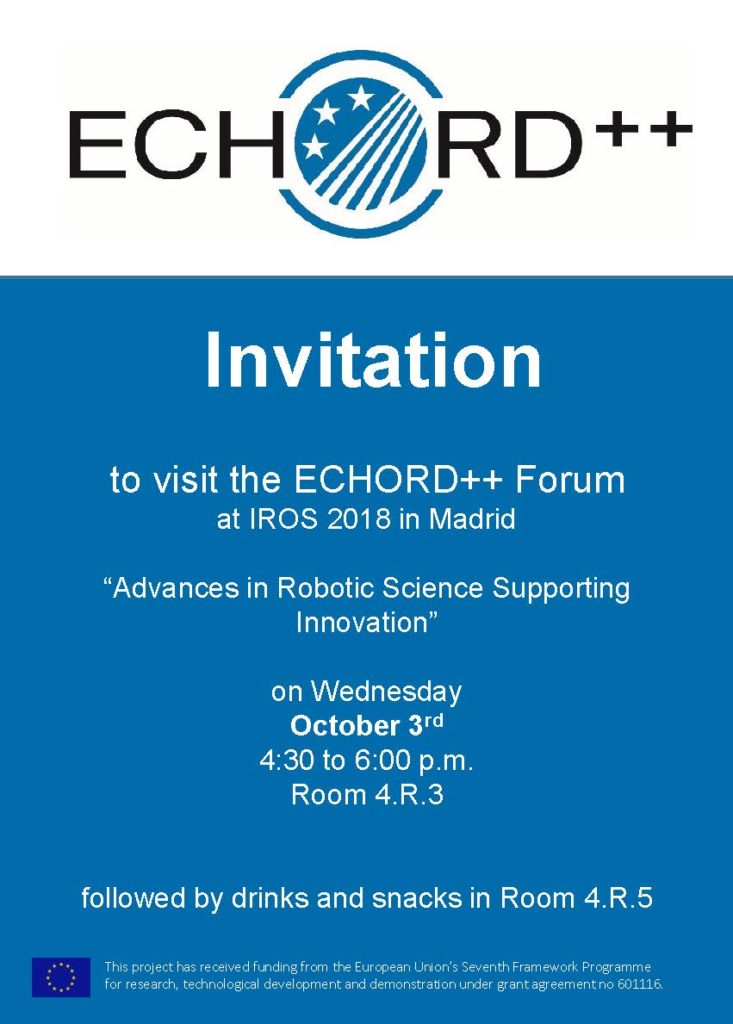 WeLead 2018, women leaders in artificial intelligence, engineering and robotics, is a journey into a new era of robotics and artificial intelligence, where we will learn about women’s research, meet interesting people, and most importantly, draw attention to the extraordinary work that women are doing in these technical fields. On June 25, 2019 at 6:30 [...]
WeLead 2018, women leaders in artificial intelligence, engineering and robotics, is a journey into a new era of robotics and artificial intelligence, where we will learn about women’s research, meet interesting people, and most importantly, draw attention to the extraordinary work that women are doing in these technical fields. On June 25, 2019 at 6:30 [...]
The post WeLead goes to the second round appeared first on The European Coordination Hub for Open Robotics Development.
]]>WeLead 2018, women leaders in artificial intelligence, engineering and robotics, is a journey into a new era of robotics and artificial intelligence, where we will learn about women’s research, meet interesting people, and most importantly, draw attention to the extraordinary work that women are doing in these technical fields. On June 25, 2019 at 6:30 pm there will be a second round for this amazing conference.
Women in Autonomous Driving
Is autonomous driving a male-dominated field? This technology, one of the ground breaking applications of AI and robotics cannot be just populated by males in the scientific, technical and leadership areas. Do you want to know more? All gender and backgrounds are invited to this event where three renown speakers will share their knowledge about the algorithms, the technology and the future of the autonomous cars.
You find more information here: http://weleadwomen.wordpress.com
You can register here: www.eventbrite.de/
The post WeLead goes to the second round appeared first on The European Coordination Hub for Open Robotics Development.
]]>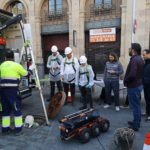 “Excellent” and “our expectations were by far exceeded” — these were some of the statements that international experts made end of March as an overall conclusion to the end of the EU project ECHORD++. ECHORD++ had a runtime of five years and was coordinated under the direction of Prof. Alois Knoll of the Technical University [...]
“Excellent” and “our expectations were by far exceeded” — these were some of the statements that international experts made end of March as an overall conclusion to the end of the EU project ECHORD++. ECHORD++ had a runtime of five years and was coordinated under the direction of Prof. Alois Knoll of the Technical University [...]
The post Robots mastering every situation appeared first on The European Coordination Hub for Open Robotics Development.
]]>“Excellent” and “our expectations were by far exceeded” — these were some of the statements that international experts made end of March as an overall conclusion to the end of the EU project ECHORD++. ECHORD++ had a runtime of five years and was coordinated under the direction of Prof. Alois Knoll of the Technical University of Munich (TUM).
ECHORD++ supervised application-oriented projects from almost all areas of robotics research and application: Robots as assistant systems in hospital operations, for rehabilitation, in agriculture, logistics, the service industry, for monitoring public sewers, as thinking employees in production and waste management and many other use cases. The very diverse application areas of the project brought together partners from many European countries. According to Professor Knoll, ECHORD++ faced the “absurd” problem that scientists applied in close collaboration with industrial partners for over 250 research projects, but only 32 of them were approved and funded. In the end, ECHORD++ had the largest network in robotics with almost 110 project partners and more than 1000 participants from Iceland to Spain.
Although each individual project was only funded for 18 months and some of the projects have just recently been completed, four startup companies were created, with more waiting in the wings. This was made possible by the strict alignment of the projects with the needs of the market and the close cooperation with corresponding industrial partners. For example, in collaboration with two Swedish recycling companies (Stena Recycling and Refind Technologies), a robot has emerged that can differentiate and sort batteries and accumulators.
New ways of funding
During the lifetime of ECHORD++, three so-called Robotic Innovation Facilities (RIFs) were set up: in Bristol / Great Britain, in Paris-Saclay / France, and in Pontedera / Italy. These centers offer free access to high-tech robotic equipment and expertise for SMEs within the European Union. The RIFs will continue to exist, as the inflow of small enterprises is enormous and so is their economic success. There are plans to link these centers more closely in the future, and thus to increase their success through synergy effects.
Another innovation in ECHORD++ was the introduction of Public End-user Driven Technological Innovation (PDTI), a new way of funding for the public sector. Two areas of application seemed particularly suitable: robots for monitoring the urban sewers and robots for the comprehensive geriatric diagnostics in hospitals. With the concept of PDTI facilitation, four promising projects should be put into deployment as soon as possible in close cooperation with hospitals and municipalities. Together with the city council of Barcelona, a moving and a flying robot were created to monitor the narrow sewers. They send images to the outside in real time, thus saving employees from having to climb in person into these tight and unpleasant working premises. As part of the review, the evaluators were able to watch the operation of these two robots “live” in Barcelona, well protected of course.
The two different concepts for a comprehensive geriatric examination include the so-called Barthel test, which assesses the ability of elderly patients to cope with everyday life and their mobility. These tasks are performed automatically by the robot without the need of a doctor. This saves a considerable amount of time in hospital operation because the doctor is already fully informed in advance and can plan therapy or support measures accordingly.
39 million for future robots
ECHORD++ already had a predecessor: ECHORD. Altogether more than ten years of robotics technology could be developed and researched. The European Union has invested almost 39 million euros in total and has taken a completely new approach. Unlike before, it entrusted this funding in its entirety to the consortium, which in turn developed and published relevant calls for research topics and evaluated them scientifically together with international experts. 80% of the funding went to projects outside the core consortium. “Automation, robotics and artificial intelligence are the core technologies that our society will have to deal with in the future,” says Prof. Knoll. “It is enormously important that the EU supports this research and development with substantial funding in order to keep the European robotics industry at the forefront.”

The public sewer system has to be checked regularly and is a very unpleasant workplace. Robots work accurately, transfer all the information to the outside in real time and have no sensitive nose. (Photo: SIAR)
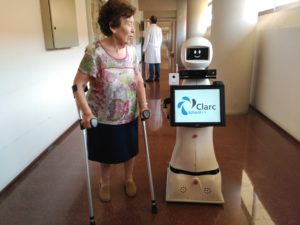
This robot saves a lot of time in the hospital, because it independently carries out standardized tests with the patients and then accompanies them to the doctor’s room. (Photo: CLARC)
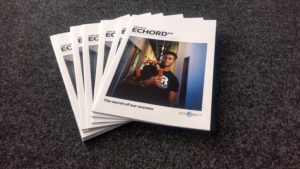
At the end of the project, a brochure has been published, which can be downloaded on the website (https://echord.eu) or ordered as a printed edition free of charge via [email protected]. (Photo: ECHORD++)
The post Robots mastering every situation appeared first on The European Coordination Hub for Open Robotics Development.
]]>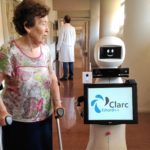 What does it take to create jobs and economic growth with EU-funded research projects? The ECHORD projects demonstrate how the EC supports creating commercial impact in robotics We cordially invite you to join us for a breakfast at the EU Parliament on April 2nd from 8-9:30a.m. In 10 years of research in robotics the EU-funded [...]
What does it take to create jobs and economic growth with EU-funded research projects? The ECHORD projects demonstrate how the EC supports creating commercial impact in robotics We cordially invite you to join us for a breakfast at the EU Parliament on April 2nd from 8-9:30a.m. In 10 years of research in robotics the EU-funded [...]
The post Breakfast with robots at the EU Parliament on April 2nd appeared first on The European Coordination Hub for Open Robotics Development.
]]>What does it take to create jobs and economic growth with EU-funded research projects? The ECHORD projects demonstrate how the EC supports creating commercial impact in robotics
We cordially invite you to join us for a breakfast at the EU Parliament on April 2nd from 8-9:30a.m.
In 10 years of research in robotics the EU-funded projects ECHORD and ECHORD++ have generated amazing results – not only in outstanding technology development but also in products that have already reached the market, leading to economic growth and job creation in Europe.
To present you the benefits of long-running EU-funded projects using ECHORD and ECHORD++ as an example, I would like to invite you to a breakfast at the European Parliament in Brussels on April 2nd, 2019 at 8 am (rue Wiertz 60, Brussels). This is an occasion for us to feel the robotics technology created and to get the spirit of successful industry-academia collaborations in robotics. After short presentations by the European Commission and the project consortium we will have the opportunity to take a close look at prototypes emerged from the projects and to discuss the future of robotics in Europe.
Programme:
8:00 am: Welcome address by Pilar del Castillo
8:10 am: Dr. Khalil Rouhana, Deputy Director general at DG CONNECT: ECHORD and ECHORD++ — a success story
8:20 am: Prof. Dr. Alois Knoll (Technical University of Munich): A bridge to the future – how to transfer the concept of stakeholder engagement from robotics to artificial intelligence
8:30 am: Prof. Dr. Alberto Sanfeliu Cortés (Universitat Politècnica de Catalunya): Robots in the underground
8:40 am: Prof. Dr. Christophe Leroux (CEA): Creating robotic ecosystems for open innovation
8:50 am – 9:30 am: Open discussion, touch & feel a robot for healthcare
For people coming from outside the Parliament: please confirm your participation with full name, date of birth and ID number by email to [email protected]
The post Breakfast with robots at the EU Parliament on April 2nd appeared first on The European Coordination Hub for Open Robotics Development.
]]>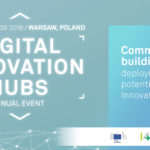 The EU-funded project ECHORD++ was the first European project to set up Robotic Innovation Facilities offering access to high-tech robotic equipment and expertise to research organisations, companies and institutions. ECHORD++ presenting lessons learned from Robotic Innovation Facilities (RIFs) at the DIH annual event in Warsaw, 27 & 28 November The 2018 edition of the Digital [...]
The EU-funded project ECHORD++ was the first European project to set up Robotic Innovation Facilities offering access to high-tech robotic equipment and expertise to research organisations, companies and institutions. ECHORD++ presenting lessons learned from Robotic Innovation Facilities (RIFs) at the DIH annual event in Warsaw, 27 & 28 November The 2018 edition of the Digital [...]
The post Digital Innovation Hubs annual event in Warsaw appeared first on The European Coordination Hub for Open Robotics Development.
]]>The EU-funded project ECHORD++ was the first European project to set up Robotic Innovation Facilities offering access to high-tech robotic equipment and expertise to research organisations, companies and institutions.
ECHORD++ presenting lessons learned from Robotic Innovation Facilities (RIFs) at the DIH annual event in Warsaw, 27 & 28 November
The 2018 edition of the Digital Innovation Hubs annual event will take place in Warsaw, co-organised this year by the European Commission, the Department of Innovation at the Polish Ministry of Entrepreneurship and Technology, and the EU-funded initiative I4MS.
The aim of this event is to reinforce the capacity of Digital Innovation Hubs (DIHs) to support European companies in their digital transformation. SMEs, start-ups, research and technology organisations, DIHs and policy-makers from all around Europe are invited to participate.
Marie-Luise Neitz from Technical University of Munich is the coordinator of the ECHORD++ project. She will give a talk at the DIHs to deploy AI and robotics across Europe – session on tuesday 27nd at 4:30 p.m.
The session will bring together DIHs focusing on AI and robotics to showcase their achievements in supporting SMEs.
The session will present how the collaboration between the DIHs on AI and robotics can be further enhanced across the EU and in particular discuss how the link between them and other DIHs can be facilitated in future, also under the Digital Europe Programme.
The panel will also discuss how to optimise synergies and collaboration between the AI-on-Demand platform, the “toolbox for AI” and the DIHs network, “distribution channel for AI”.
Where?
Polish Ministry of Entrepreneurship and Technology. Plac Trzech Krzyży 3/5, 00-507 Warsaw, Poland
The post Digital Innovation Hubs annual event in Warsaw appeared first on The European Coordination Hub for Open Robotics Development.
]]>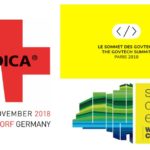 In November you will have the chance to meet members of the ECHORD++ consortium personally, whether you are in Germany, Spain or France … Do not miss these great opportunities to meet with ECHORD++ 12. November – The GovTech Summit in Paris, France Hôtel de Ville de Paris Marie-Luise Neitz from TUM will be [...]
In November you will have the chance to meet members of the ECHORD++ consortium personally, whether you are in Germany, Spain or France … Do not miss these great opportunities to meet with ECHORD++ 12. November – The GovTech Summit in Paris, France Hôtel de Ville de Paris Marie-Luise Neitz from TUM will be [...]
The post ECHORD++ at three events in November appeared first on The European Coordination Hub for Open Robotics Development.
]]>In November you will have the chance to meet members of the ECHORD++ consortium personally, whether you are in Germany, Spain or France …
Do not miss these great opportunities to meet with ECHORD++
12. November – The GovTech Summit in Paris, France
Hôtel de Ville de Paris
Marie-Luise Neitz from TUM will be giving a presentation at 12:15 in Salle du Conseil, Hotel de Ville, Paris
Connecting Europe – Bringing together Citizens, Businesses and Government
EU projects develop technology and digital solutions to make public administration more effective and efficient and to bring citizens, businesses and government closer together. The session will discuss examples of ongoing work to build a Digital Single Market and provide an outlook to the future. Examples discussed include urban robotics, robotics in healthcare, public cloud services, electronic identification at municipal level and the reduction of administrative burden through the once only principle.
You can visit us at any time at the booth of the European Commission
12.-15. November – MEDICA 2018 in Düsseldorf, Germany
Messe Düsseldorf
Visit our booth at the leading international trade fair in the medical sector in Hall 12 Booth F37 .
ECHORD++ will be showcasing four of the healthcare experiments within the project: CLARC, Assesstronic, EXOtrainer and LINarm++.
Do not miss our speeches at the MEDICA Forums:
- MEDICA TECH FORUM, November 12th at 4 p.m.
Juan Pedro Bandera Rubio from Universidad de Malaga talking about the PDTI project CLARC - MEDICA CONNECTED HEALTHCARE FORUM, November 15th at 3 p.m.
Manuel Prieto from Marsi Bionics will give us a talk on the EXOtrainer experiment
13.-15. November Smart City Expo World Congres in Barcelona, Spain
Fira de Barcelona
Get to see our robotic solutions for Sewer Inspection SIAR and ARSI live! in Gran Via, Hall2, Level 0, Street E, Booth 506
Look for “Proyecto ECHORD++” in the programme.
We hope to see you at one of the events!
The post ECHORD++ at three events in November appeared first on The European Coordination Hub for Open Robotics Development.
]]> Sebastian Weisenburger, PR Specialist from TUM, in charge of disseminationof the ECHORD++ project, explains the EU funded project ECHORD++ in a way, which is easy to understand for everyone. Sebastian, whose background is in Philosophy and Politics, shares with us how he got into Robotics, and why his background was benficial for this job. [...]
Sebastian Weisenburger, PR Specialist from TUM, in charge of disseminationof the ECHORD++ project, explains the EU funded project ECHORD++ in a way, which is easy to understand for everyone. Sebastian, whose background is in Philosophy and Politics, shares with us how he got into Robotics, and why his background was benficial for this job. [...]
The post Tell us all about the ECHORD++ project, Sebastian! appeared first on The European Coordination Hub for Open Robotics Development.
]]>Sebastian Weisenburger, PR Specialist from TUM, in charge of disseminationof the ECHORD++ project, explains the EU funded project ECHORD++ in a way, which is easy to understand for everyone.
Sebastian, whose background is in Philosophy and Politics, shares with us how he got into Robotics, and why his background was benficial for this job.
He describes the structure of the EU-funded ECHORD++ project and what makes it unique.
ECHORD++ works with application oriented research, bringing together academia, industry and end users under the banner “From lab to market”.
“It is important for people to step out of their worlds, talk to people from other domains and exchange ideas and needs of researchers and end-users of the technology”, says Sebastian,
“ECHORD++ bridges this gap between R&D and the end-user”.
In this interview we hear about Public end-user Driven Technological Innovation (PDTI), where currently one challenge is running in healthcare and one in urban robotics.
We also learn about the Robotic Innovation Facilities (RIFS), which are open labs that offer high-tech equipment and expertise for private people and SMEs.
Watch the complete interview by Per Sjöborg from Patreon. on youTube: https://youtu.be/K35eYEqEx1Q
The post Tell us all about the ECHORD++ project, Sebastian! appeared first on The European Coordination Hub for Open Robotics Development.
]]> Ladies (and Gentlemen!), November 17th is your opportunity. Come and meet some of the most interesting and successful women working on artificial intelligence with their human intelligence. The conference WeLead (Women Leaders in Artificial Intelligence, Engineering and Robotics) showcases the contribution of women’s research and the extraordinary work that they are doing in these technical [...]
Ladies (and Gentlemen!), November 17th is your opportunity. Come and meet some of the most interesting and successful women working on artificial intelligence with their human intelligence. The conference WeLead (Women Leaders in Artificial Intelligence, Engineering and Robotics) showcases the contribution of women’s research and the extraordinary work that they are doing in these technical [...]
The post Meet female research appeared first on The European Coordination Hub for Open Robotics Development.
]]>Ladies (and Gentlemen!), November 17th is your opportunity. Come and meet some of the most interesting and successful women working on artificial intelligence with their human intelligence. The conference WeLead (Women Leaders in Artificial Intelligence, Engineering and Robotics) showcases the contribution of women’s research and the extraordinary work that they are doing in these technical fields. It takes place at TUM Audimax (on main campus in downtown Munich) from 3-7 pm.
WeLead offers a journey into a new era of robotics and artificial intelligence and provides three dissemination technical talks and one life experience speech. One of the talks will be given by Dr. Elena Garcia, member of ECHORD++ and one of the researchers of the Exotrainer experiment, which is now commercialized as ATLAS2030 by Marsi Bionics.
Use this opportunity to meet and talk to the WeLeaders, to colleagues and to share experiences. The conference is free of charge, but you need to register on https://weleadwomen.wordpress.com/register/.
The post Meet female research appeared first on The European Coordination Hub for Open Robotics Development.
]]>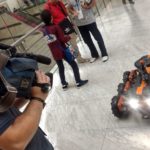 This past week, over 3000 attendees from across the world gathered in sunny Madrid, Spain, for the IEEE/RSJ International Conference on Intelligent Robots and Systems (IROS). Visitors were offered high-level presentations given by researchers and tech company representatives, as well as the 150 exhibitors, showcasing the latest advances in intelligent robots, humanoids, autonomous cars, service [...]
This past week, over 3000 attendees from across the world gathered in sunny Madrid, Spain, for the IEEE/RSJ International Conference on Intelligent Robots and Systems (IROS). Visitors were offered high-level presentations given by researchers and tech company representatives, as well as the 150 exhibitors, showcasing the latest advances in intelligent robots, humanoids, autonomous cars, service [...]
The post This was IROS Madrid 2018 appeared first on The European Coordination Hub for Open Robotics Development.
]]>This past week, over 3000 attendees from across the world gathered in sunny Madrid, Spain, for the IEEE/RSJ International Conference on Intelligent Robots and Systems (IROS).
Visitors were offered high-level presentations given by researchers and tech company representatives, as well as the 150 exhibitors, showcasing the latest advances in intelligent robots, humanoids, autonomous cars, service robots in medical applications, assistance, agriculture, maintenance and inspection of infrastructures, rescue, aerial, terrestrial, submarine robotics, etc.
The ECHORD++ booth was situated in the EU Exhibition Area presenting four prototypes: CLARC, EXOTRAINER, LINarm++ and SIAR. ANYmal, which started as the ECHORD++ Experiment MODUL, had its own booth in the main exhibition area. All the exhibits found lots of interest and some were even featured on Spanish television. http://rtve.es/v/4777498?t=25m13s (IROS report from minute 25)
ECHORD++ Forum “Advances in Robotic Science Supporting Innovation”on October 3rd
The aim of the forum was to share the results of 35 robotic experiments, PDTIs and Robotic Innovation Facilities financed under the ECHORD++ European Project and the lessons learned in the innovative procedures developed during the past five years.
GEOFF PEGMAN, Managing Director of RURobots, moderated the Forum, in which Dr. CECILE HUET, Head of Unit Robotics and Artificial Intelligence of the European Commission spoke about the role of ECHORD++ as a pioneer for new tools in EU funding programmes and a booster of technology transfer.
Prof. Dr.-Ing. ALOIS KNOLL from Technical University of Munich, gave a retrospective of the past 10 years as the coordinator of the ECHORD project and its successor ECHORD++, in which two new instruments, RIFs (Robotics Innovation Facilities) and PDTI (Public end-user Driven Technological Innovation) were introduced.
Prof. Dr. CHRIS MELHUISH from Bristol Robotics Laboratory, Bristol, United Kingdom outlined the importance of RIFs to attract new user groups and Prof. Dr. ALBERTO SANFELIU from Universitat Politècnica de Catalunya, Barcelona, explained in detail how the tailor-made robotics solutions for customers in the public sectors developed to the so-called PDTIs (Public End-user Driven Technological Innovation).
Prof. Dr. PAOLO DARIO from the BioRobotics Institute – Scuola Superiore Sant’ Anna, Pisa, spoke about the third instrument of the ECHORD++ project, the Experiments, who were provided incentives to encourage European robot manufacturers and research institutes to work together on an operational level, with tangible and measurable results to accelerate the development of technologies and their deployment into new application scenarios.
As an example for a successful technology transfer in Experiments, Dr. ELENA GARCIA from CAR.UPM-CSIC. MARSIBIONICS spoke about the EXOTRAINER prototype, and PAULO ALVITO from IDMIND presented his PDTI Urban prototype for Sewer Inspection Autonomous Robot SIAR.
After the Forum drinks and snacks were served for all participants.

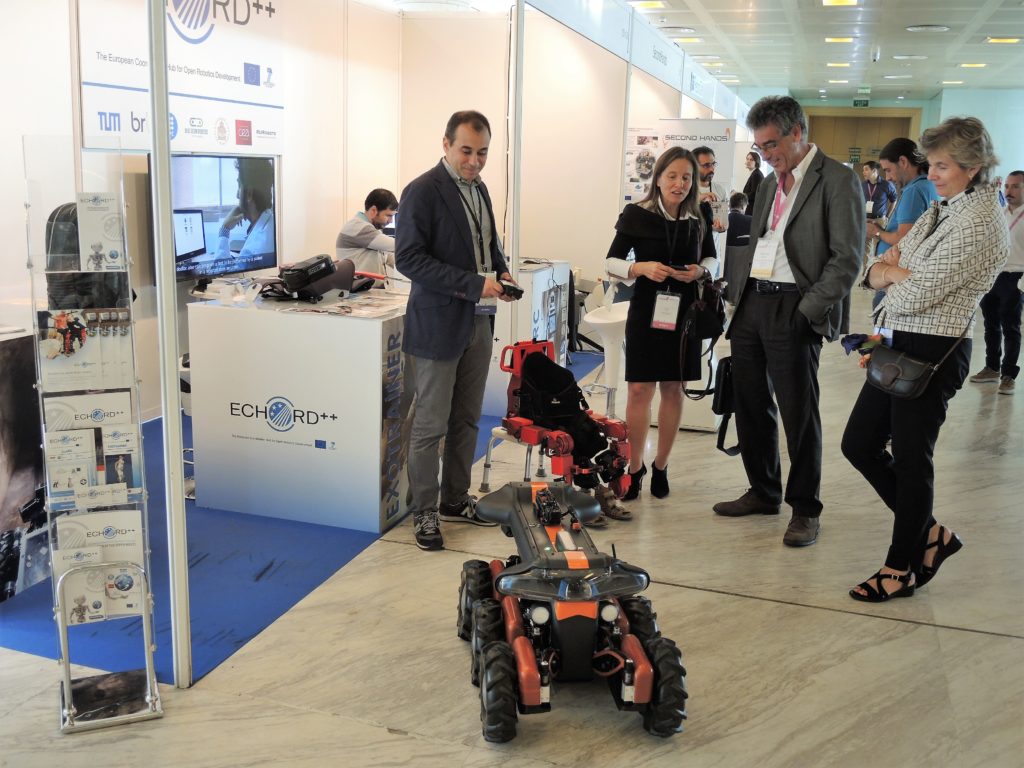
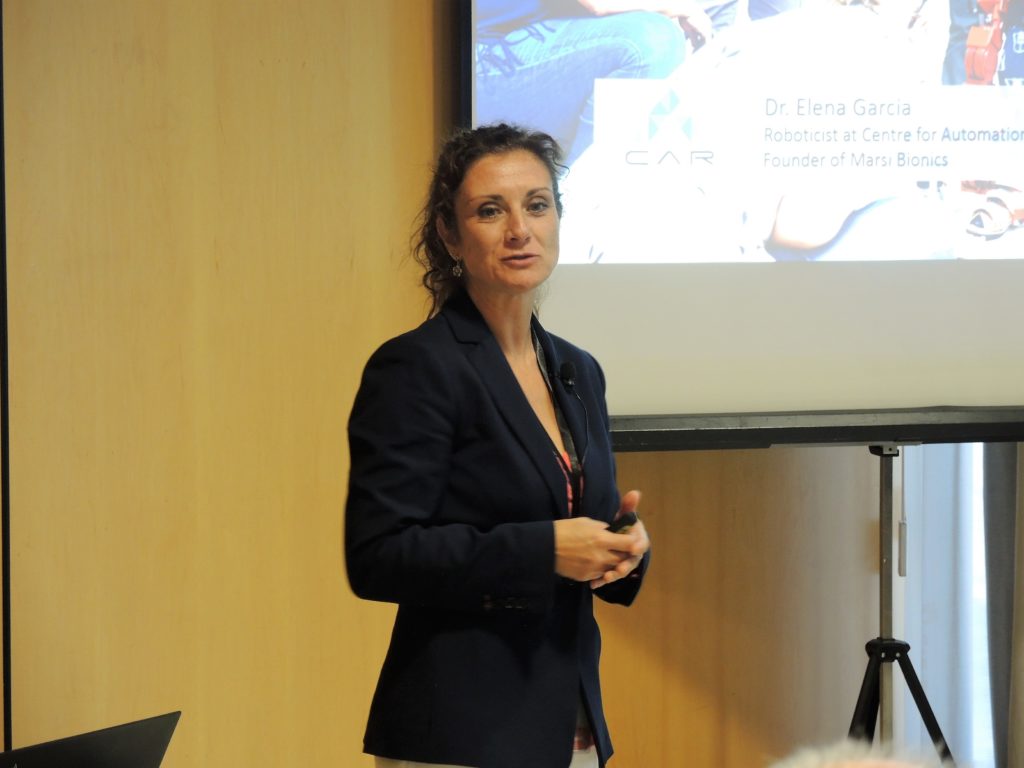


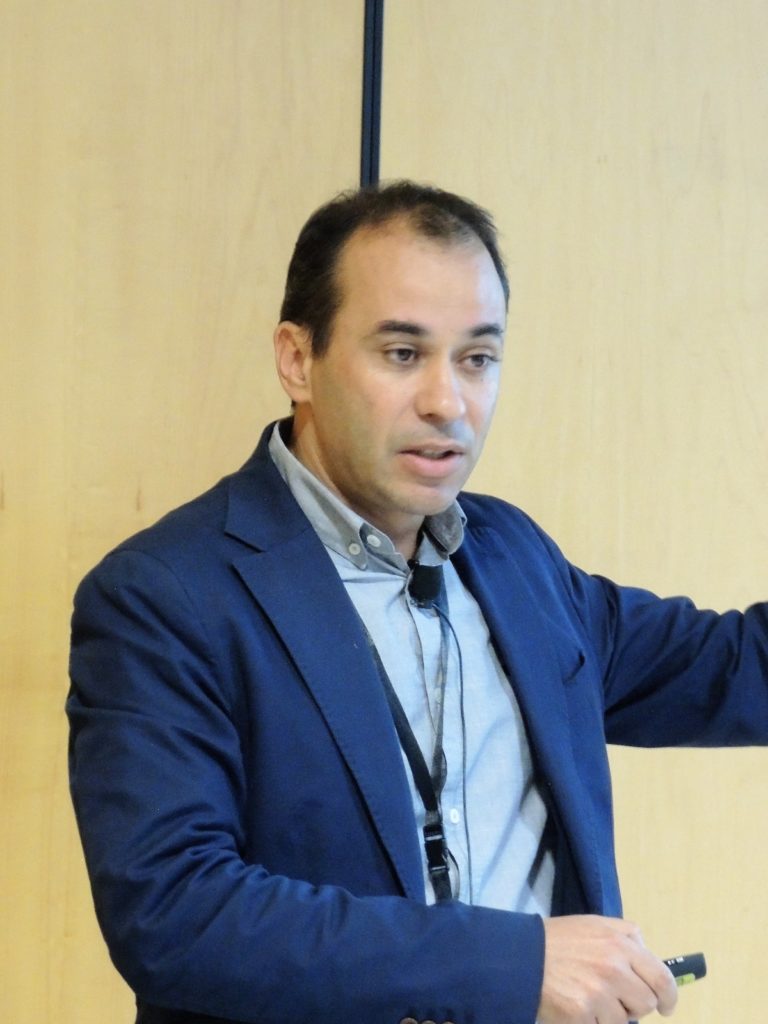
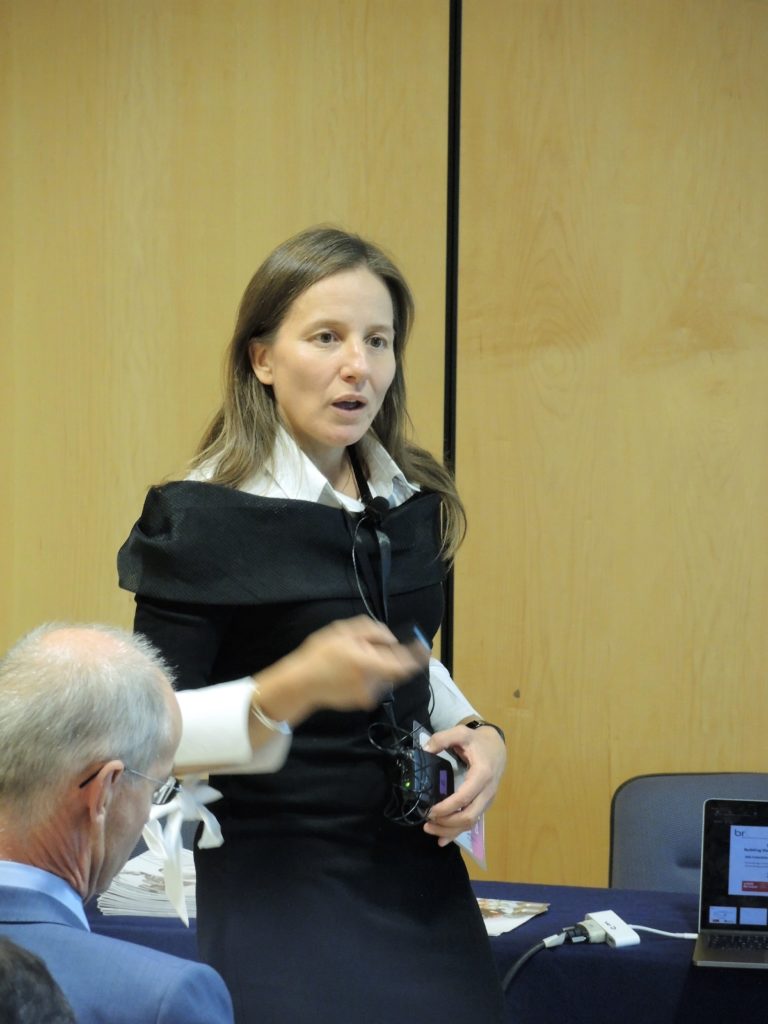
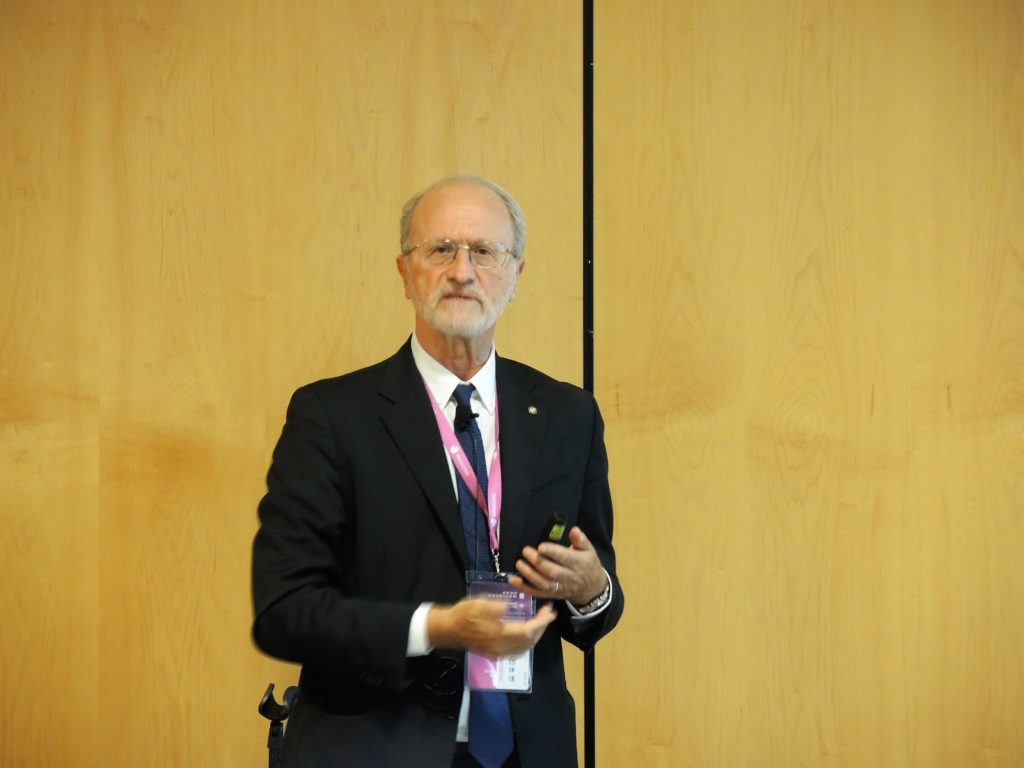
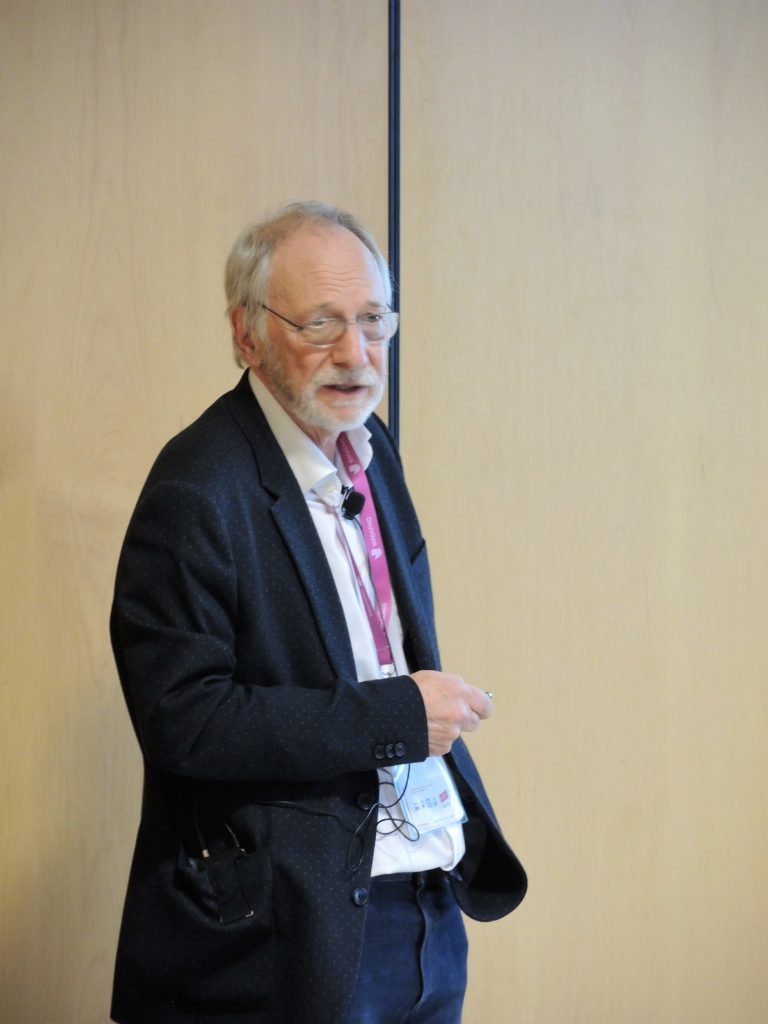
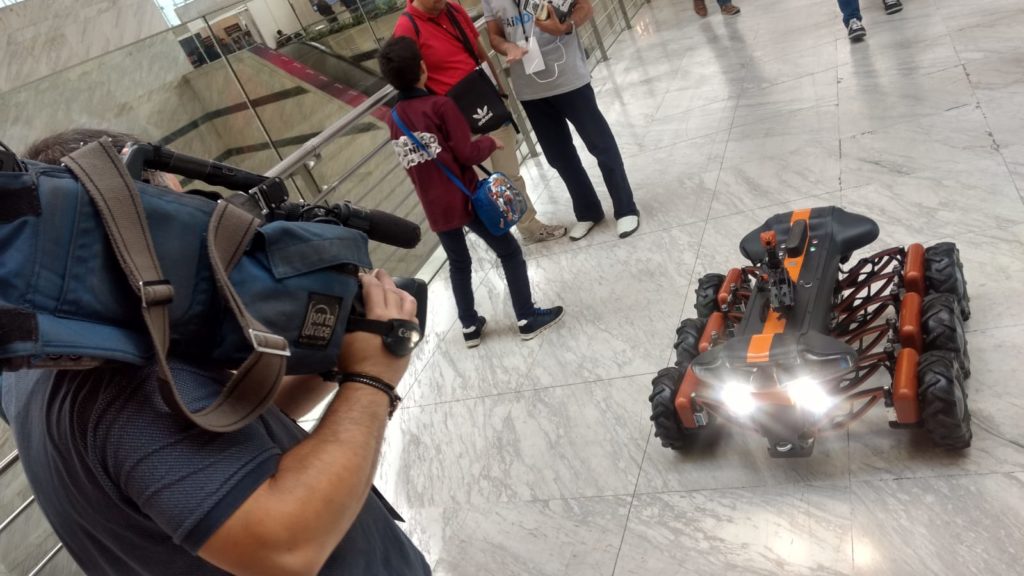
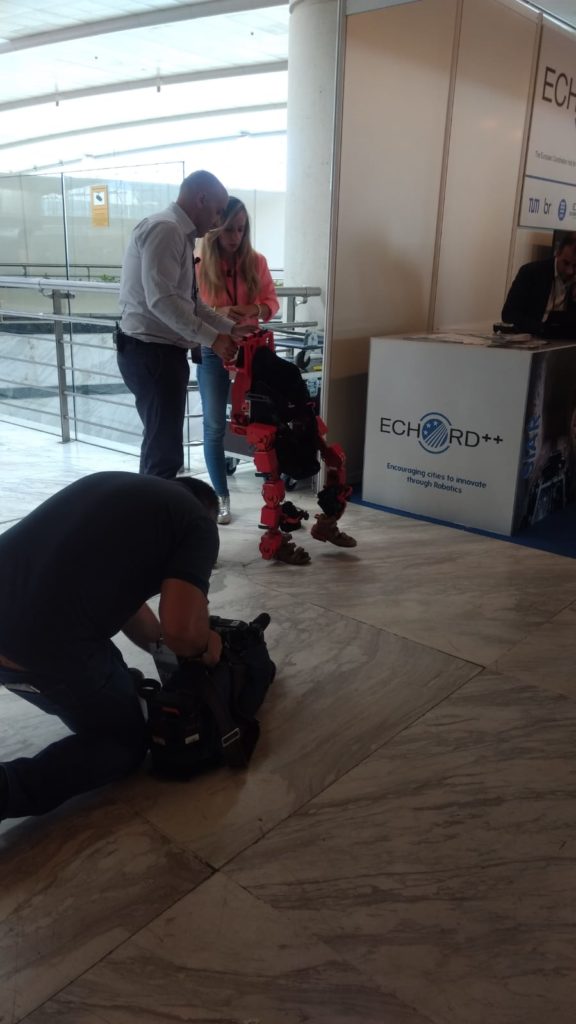
The post This was IROS Madrid 2018 appeared first on The European Coordination Hub for Open Robotics Development.
]]>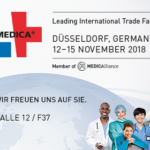 Robots – the talented caretakers of the future Robots are taking on more and more rehabilitation and support tasks, relieving nurses and doctors. Some of these applications the EU project Echord ++ will present at the Medica trade fair on November 12-15, in Dusseldorf in hall 12 (booth F 37). Older patients often have limitations [...]
Robots – the talented caretakers of the future Robots are taking on more and more rehabilitation and support tasks, relieving nurses and doctors. Some of these applications the EU project Echord ++ will present at the Medica trade fair on November 12-15, in Dusseldorf in hall 12 (booth F 37). Older patients often have limitations [...]
The post ECHORD++ at MEDICA 2018 appeared first on The European Coordination Hub for Open Robotics Development.
]]>Robots – the talented caretakers of the future
Robots are taking on more and more rehabilitation and support tasks, relieving nurses and doctors. Some of these applications the EU project Echord ++ will present at the Medica trade fair on November 12-15, in Dusseldorf in hall 12 (booth F 37).
Older patients often have limitations in organic, personal and social areas and these documented changes determine the therapy. A thorough history requires much more time with seniors, because they cannot collaborate as younger patients and tire out more quickly. A comprehensive geriatric examination, however, offers the opportunity to help the patient early and in a qualified manner, thus enabling him to lead a self-determined life.
Support for doctors
Some of these examinations may not necessarily require a doctor or caregiver. A robot like the Assesstronic prototype can take over some of these tasks. It can understand, interpret and classify voice, gestures or touch of the patient. Assesstronic collects this data independently, processes and saves it so that they are always available. The doctor saves a lot of time and the innovative product is also inexpensive, because it relies on standard hardware.
The CLARC prototype is designed to allow clinicians to save time by driving several standard tests of a comprehensive geriatric assessment without human supervision. The robot captures the responses, monitors the patient’s motion, records all data (video and audio) and scores the tests. The clinician can subsequently analyse all these multimedia information, edit the scores and evaluate the evolution of the patient over time. Since the robot can move freely in the care centre, patients love him. CLARC already receives them at the entrance and guides them calmly to the examination room – a great relief, because they only have to follow it.
Robotics intensifies rehabilitation measures
Intense and assisted rehabilitation therapies plays an important role in the recovery process after stroke. The prototype LINarm++ supports the patient in the rehabilitation of the upper limb. It adapts the difficulty and support levels to the abilities of the patient by monitoring his performances and physiological state. A visual feedback motivates him and keeps his attention. LINarm++ is compact and affordable, and the patient can easily use it at home, unlike other training systems.
The MAK Active Knee orthosis helps patients after stroke or a knee operation to train this joint as effectively as possible and to make it movable again. It includes an intelligent detector system that automatically adjusts to the patient’s gait and strength, allowing him to even climb stairs and descend slopes.
Spinal muscular atrophy is a genetic disease, which comes in various forms that are hitherto incurable. Movement is limited, if at all. At the same time, exercise is very important to reduce the side effects and course of the disease and to increase the quality of life of those affected. There are already a number of exoskeletons on the market, the ExoTrainer, however, was specially developed for children and is now commercially available as ATLAS 2020. It contains 10 actuators and an optimized design with only 14 kg weight. The exosceleton lets children move on their own and improves their quality of life significantly. By the way, the health insurance companies save annually high amounts, which arise from the prevented side effects of the disease.
Two talks of ECHORD++ scientists at the MEDICA Forums
A talk at the MEDICA CONNECTED HEALTHCARE FORUM on November 15th, 15:00 – 15:20 in Hall 15/C24 by Manuel Prieto, who will provide a deeper insight to the EXOtrainer project.
On November 12th, 16:00 h – 16:20 in Hall 12/E73, Juan Pedro Bandera Rubio will talk about the CLARC experiment in the MEDICA TECH FORUM.
The complete programme of all forums can be found on the webpage.
Download the press information in English and German.
The post ECHORD++ at MEDICA 2018 appeared first on The European Coordination Hub for Open Robotics Development.
]]>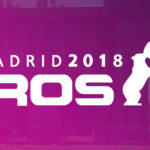 ECHORD++ will present five prototypes in the EU Exhibition Area within the IROS: CLARC, EXOTRAINER, LINarm++, SIAR, and ANYmal (MODUL) with its own booth in the main exhibition area. Do not forget to mark the ECHORD++ Forum on Wednesday, October 3rd at 4:30 p.m in your calendars. “ECHORD++: Advances in Robotic Science [...]
ECHORD++ will present five prototypes in the EU Exhibition Area within the IROS: CLARC, EXOTRAINER, LINarm++, SIAR, and ANYmal (MODUL) with its own booth in the main exhibition area. Do not forget to mark the ECHORD++ Forum on Wednesday, October 3rd at 4:30 p.m in your calendars. “ECHORD++: Advances in Robotic Science [...]
The post ECHORD++ at IROS Madrid 2018 appeared first on The European Coordination Hub for Open Robotics Development.
]]>
ECHORD++ will present five prototypes in the EU Exhibition Area within the IROS: CLARC, EXOTRAINER, LINarm++, SIAR, and ANYmal (MODUL) with its own booth in the main exhibition area.
Do not forget to mark the ECHORD++ Forum on Wednesday, October 3rd at 4:30 p.m in your calendars.
“ECHORD++: Advances in Robotic Science Supporting Innovation”
on October 3rd from 16:30 to 18:00 Room 1.R.3 – La Habana NEW ROOM NUMBER!!
IROS 2018 Madrid, Spain
This forum will be sharing the innovative results of 35 robotic experiments financed under the ECHORD++ European Project and the lessons learned in the innovative procedures developed during the past five years.
PROGRAMME
of the ECHORD++ Forum “ECHORD++: Advances in Robotic Science Supporting Innovation”
moderated by GEOFF PEGMAN, Managing Director of RURobots
16:30-16:45. Overview
Dr. CECILE HUET, Head of Unit Robotics and Artificial Intelligence
Directorate-General CONNECT, European Commission
16:45-17:00. Looking back on 10 Years of ECHORD++ – a Retrospective
Prof. Dr.-Ing. ALOIS KNOLL, Technical University of Munich, Germany
17:00-17:10. Prototypes
Prof. Dr. CHRIS MELHUISH. Bristol Robotics Laboratory, Bristol, United Kingdom
17:10-17:20. Public end-users Driven Technological Innovation
Prof. Dr. ALBERTO SANFELIU, Universitat Politècnica de Catalunya, Barcelona, Spain
17:20-17:30. Experiments
Prof. Dr. PAOLO DARIO, The BioRobotics Institute – Scuola Superiore Sant’ Anna, Pisa, Italy
17:30-17:50. Prototypes
Dr. ELENA GARCIA, CAR.UPM-CSIC. MARSIBIONICS. EXOTRAINER Prototype
PAULO ALVITO, USE-UPO-IDMIN. PDTI Urban prototype for Sewer Inspection. SIAR
17:50-18:00. Conclusions
by GEOFF PEGMAN
After the Forum drinks and snacks will be served for all the participants
For further information, see IROS2018 website
The post ECHORD++ at IROS Madrid 2018 appeared first on The European Coordination Hub for Open Robotics Development.
]]>